Transform Your Outdoor Space with These Mind-Blowing Garden Hacks!
From Wild to Wonderful
Here’s how to turn overgrown weeds into a landscaped seating area. First things first: grab your gloves and tackle the weeds! A weed whacker or sturdy rake will work fine. Once the yard is cleared, define the seating area by outlining it with stones, bricks, or edging. This will separate your garden from the surrounding space.
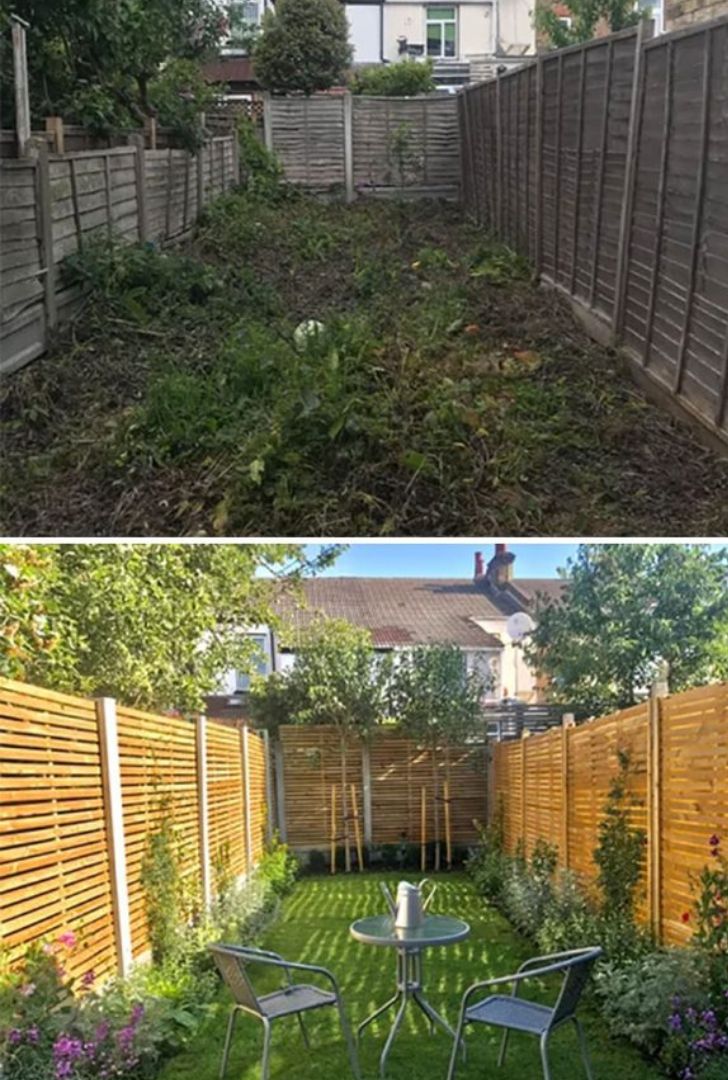
Consider repurposing old furniture or building simple wooden benches for seating. Add a touch of nature with grass, vibrant flowers, and fragrant herbs. With a little effort, your weed-filled yard can become a perfect retreat for enjoying the outdoors.
Building a Shelf Ladder From Scrap Wood
Breathe life into unused scrap wood and give your houseplants a stylish home with this DIY plant ladder shelf! This project is perfect for beginners and requires minimal tools. Simply gather flat pieces of wood for shelves and two longer pieces for the sides.
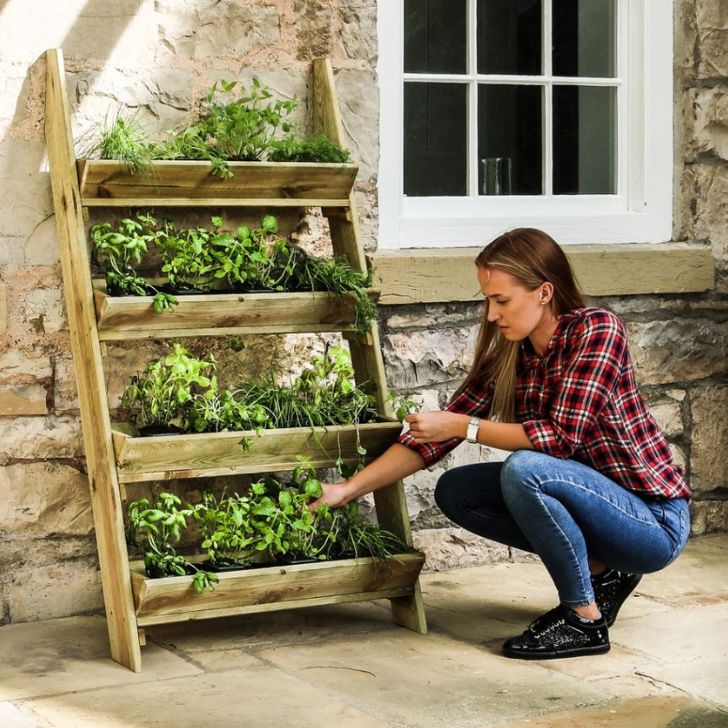
Sand them smooth for a polished touch. Then, attach the shelf boards to the sides using screws or sturdy brackets, spacing them evenly for your plants. Finally, fill your creation with your favorite greenery. You can even stain the wood, paint it a fun color, or wrap it with twine for a rustic look.
Regrow Your Greens
Don’t toss that tired lettuce yet! Turn leftovers into fresh greens with a fun regrowing project. Simply cut the base of your lettuce, leaving 1 to 2 inches of stem. Nestle this stem in a shallow dish with just enough water to cover the bottom. Place it on a sunny windowsill and watch the magic happen.
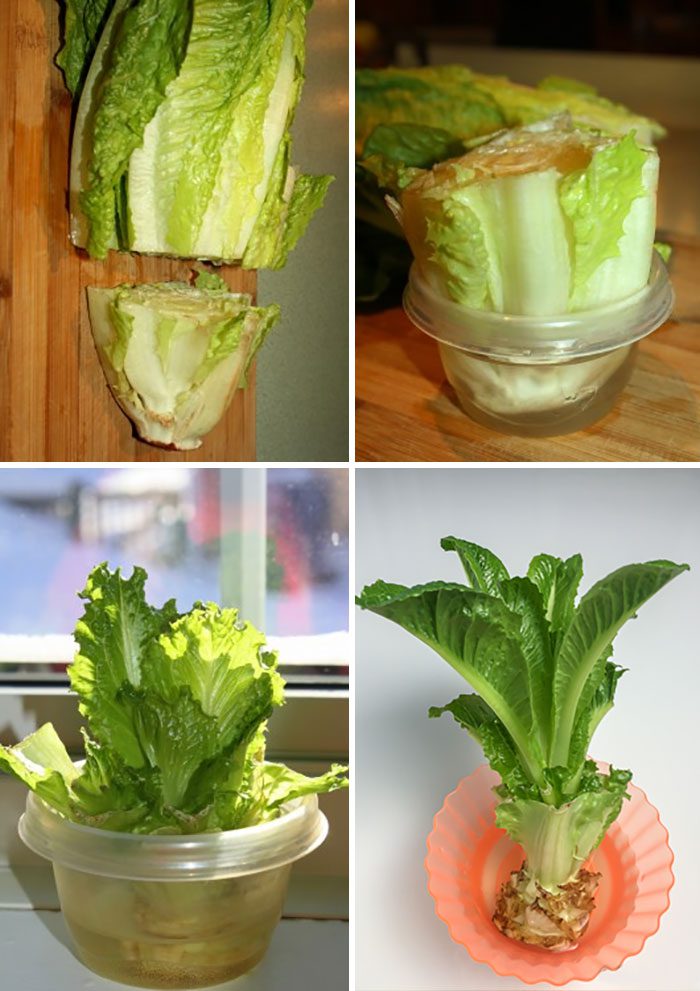
Within days, new leaves will sprout from the center. Change the water every other day to keep things fresh. While it won’t form a full head again, you’ll have enough for a delightful garnish or a mini salad in no time.
DIY Thread Irrigation System
Ditch the watering can and give your plants a spa day with this clever DIY irrigation system! You’ll need an enormous container, some string, and your plant pots. Fill the container with water and place it higher than the plants. Next, unravel a ball of yarn or thick thread, burying one end in the container of water.
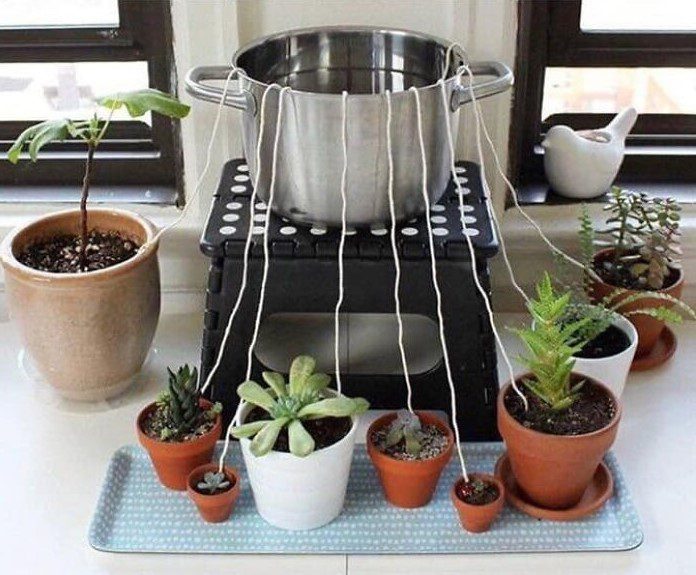
Thread the other end into the drainage hole of each plant pot. Like a tiny water bridge, the thread will naturally draw water from the container to the thirsty soil as needed. Now, your plants will stay consistently moist without overwatering.
Vertical Garden With Plastic Cans
Unleash your inner eco-warrior and create a vibrant vertical garden with recycled plastic cans and a wooden shelf! This project is perfect for lovers of upcycling in small living spaces. First, build a simple wooden frame for your shelves.
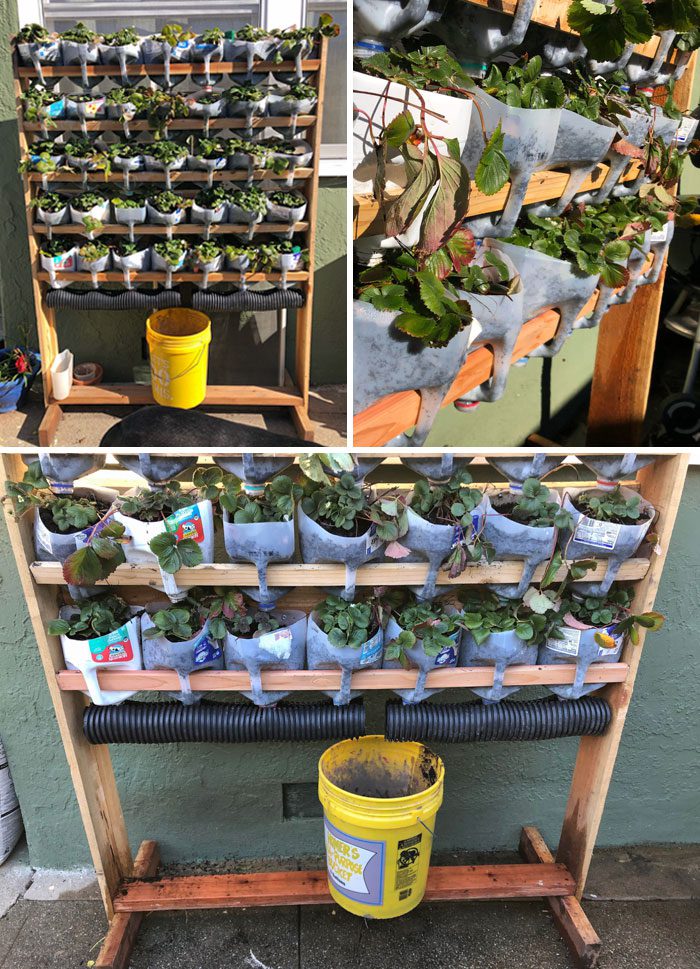
Then, get creative! Cut the tops off clean plastic cans, like soda or juice bottles. Secure the cans to the wooden shelves to ensure proper drainage. Then, fill them with potting mix and your favorite plants. You can also paint them fun colors or decorate them for a personal touch.
A Hammock for Heavy Plants
Don’t let those top-heavy plants topple over! Knit them a cozy hammock for beautiful, supported growth. The key is choosing a sturdy yarn and needles appropriate for the plant’s weight. Cast on several stitches slightly wider than your pot or plant.
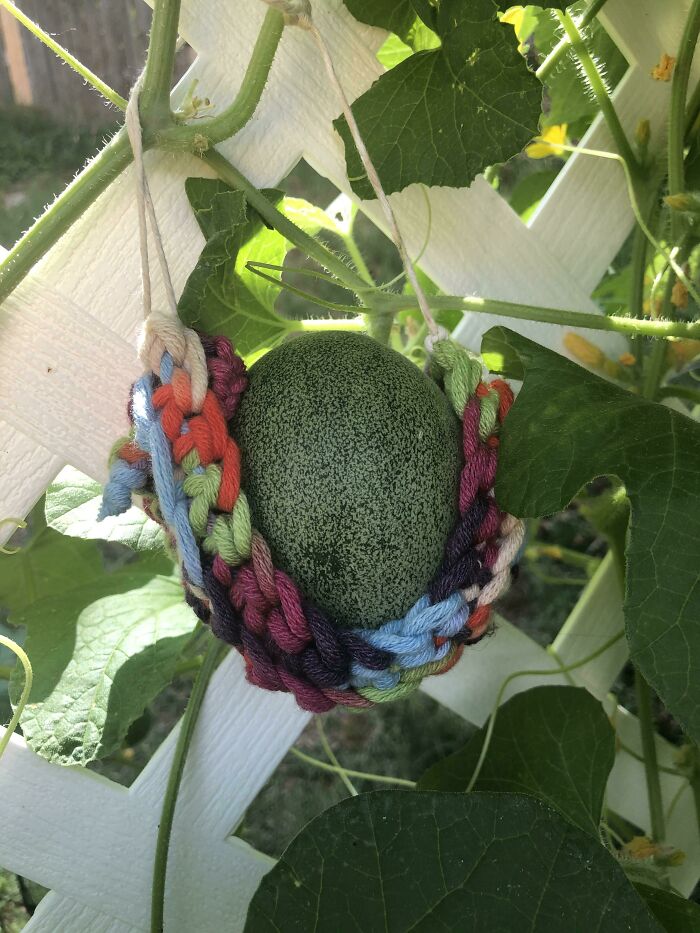
Knit in a simple stocking stitch, increasing a few stitches on each side every few rows to create a gentle cradle shape. Once large enough, bind off and weave in the ends. Slide the hammock under the plant, letting the sides drape up and support the plant’s base.
Mirror, Mirror on the Wall
Here’s a clever hack to maximize light for your precious plants on garden shelves. Mirrors act as light reflectors, boosting the brightness that greenery receives. So, get some lightweight acrylic or plastic mirrors—they’re safer than glass—and cut them to fit behind your shelves.
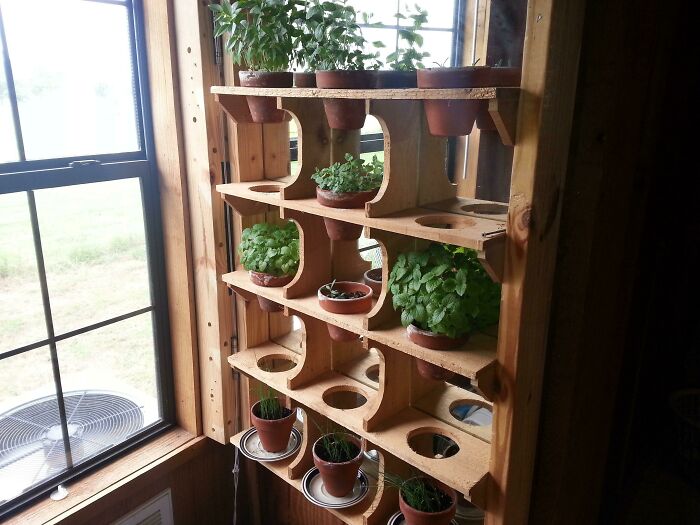
Secure the mirrors to the back panels of your shelves with a dab of weatherproof adhesive. Now, with a dab of weatherproof adhesive, watch the reflected sunlight bathes your plants from multiple angles, promoting healthy growth. This budget-friendly trick is perfect for shady areas and gives light-loving plants a little extra boost!
From Broken Shelves to Seedbeds
Don’t toss that broken furniture. Transform it into flourishing raised beds instead. Disassemble the shelves, keeping sturdy wooden pieces. Sand them smoothly for safety. Here’s the magic: Line up the wood planks like building blocks to create a rectangular or square frame.
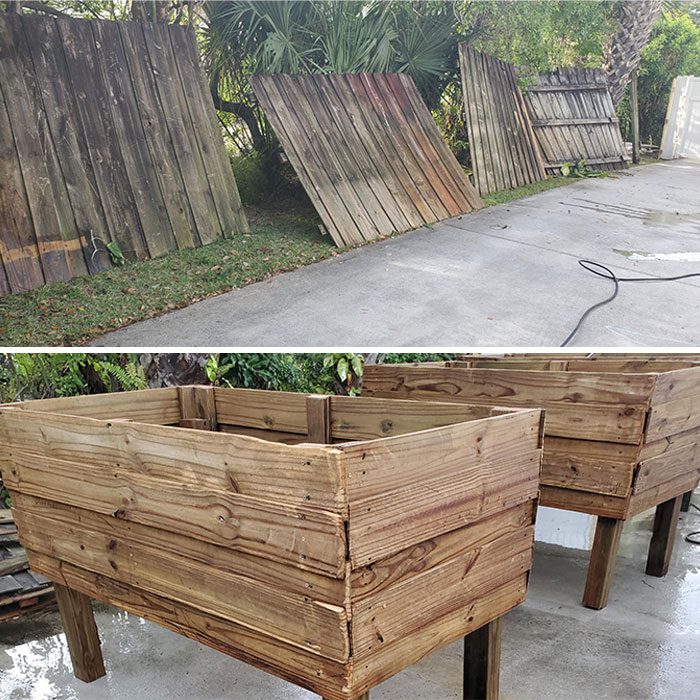
Secure the corners with screws or metal brackets for stability, and line the inside with a weed barrier to prevent unwanted guests. Wrap up by filling your creation with potting mix and your favorite flowers, herbs, or vegetables.
A Living Playhouse of Climbing Plants
Transform your garden into a whimsical wonderland with a living teepee made entirely of plants! This project is perfect for vertical gardening and creating a unique play space for children. Gather several fast-climbing vines, like morning glories or pole beans.
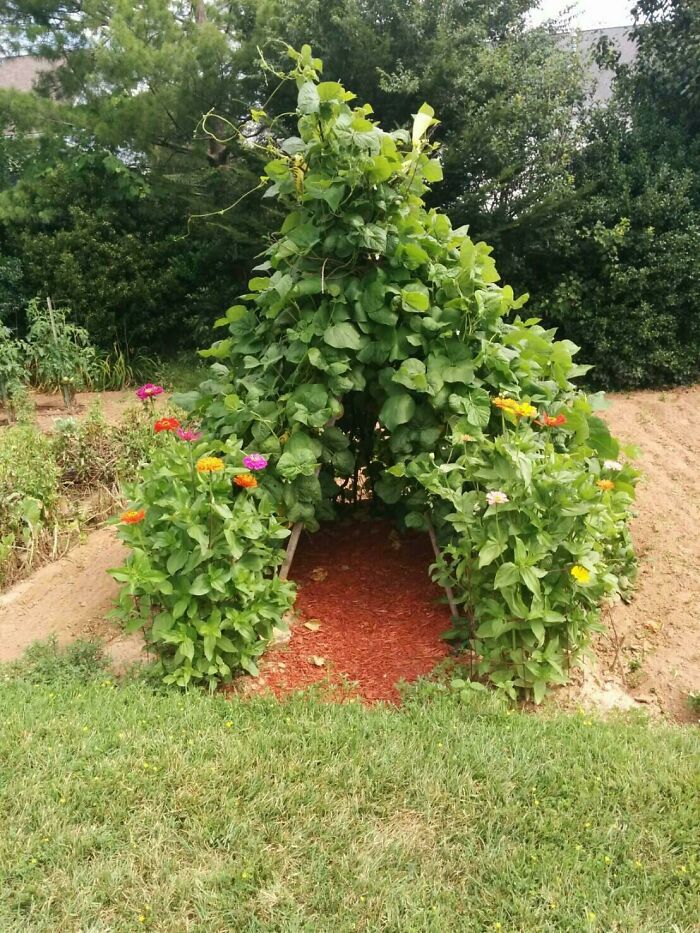
Choose a sunny spot and stake a tall, sturdy pole in the center. Now, the fun begins! Arrange 3 to 4 thinner sticks around the central pole, leaning them in at an angle to meet at the top. Secure them with twine. As your vines grow, gently guide them to twine around the support sticks, creating a leafy living structure.
A DIY Greenhouse for the Handy Gardener
This DIY greenhouse project is perfect for extending your growing season and nurturing seedlings. First, choose a sunny spot in your yard. Using scrap wood or lumber from your local store, build a simple frame – think rectangle with a slanted roof for good drainage.
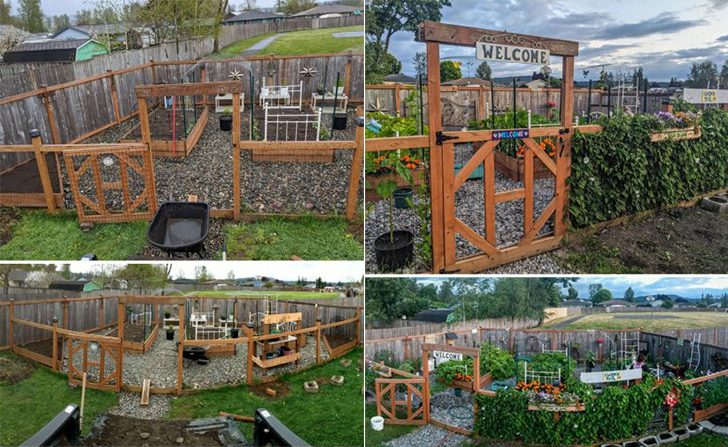
You could leave the frame bare, like in this photo. Or you could cover it with clear plastic sheeting and add small vents or hinged panels for ventilation. Now, you can enjoy nurturing seedlings, protecting delicate flowers, or extending your harvest well into the cooler months!
Planting for Positivity
Cultivate happiness and greenery with a mood-boosting garden! Start by picking a sunny spot and choosing plants that bring you joy. This person chose tulips, but fragrant herbs like lavender and chamomile that ease stress or brightly colored flowers like sunflowers are also perfect.
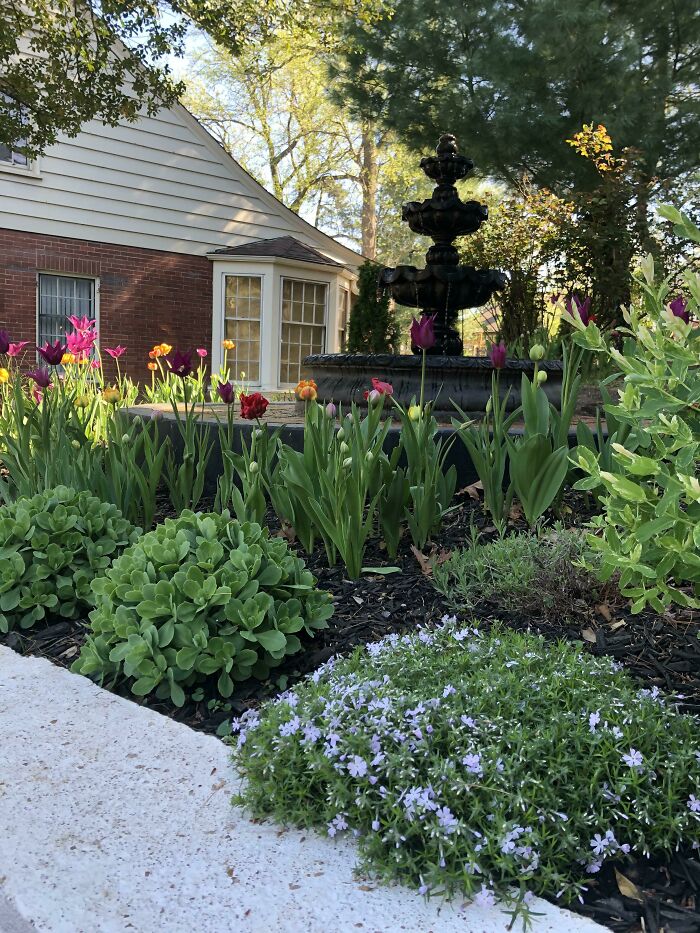
Don’t be afraid to get your hands dirty. Planting and nurturing life is surprisingly therapeutic and a beautiful way to connect with nature. Watch your garden flourish, and feel your mood brighten with every blooming flower or thriving herb.
Flower Power on the Wall
This vertical flower garden is a beautiful way to add color and life to any space! It can also serve as a space-saving solution for balconies, patios, or anywhere yearning for a floral touch. First, choose a location with good sunlight and pick flowering plants that thrive vertically, like trailing petunias or cascading lobelia.
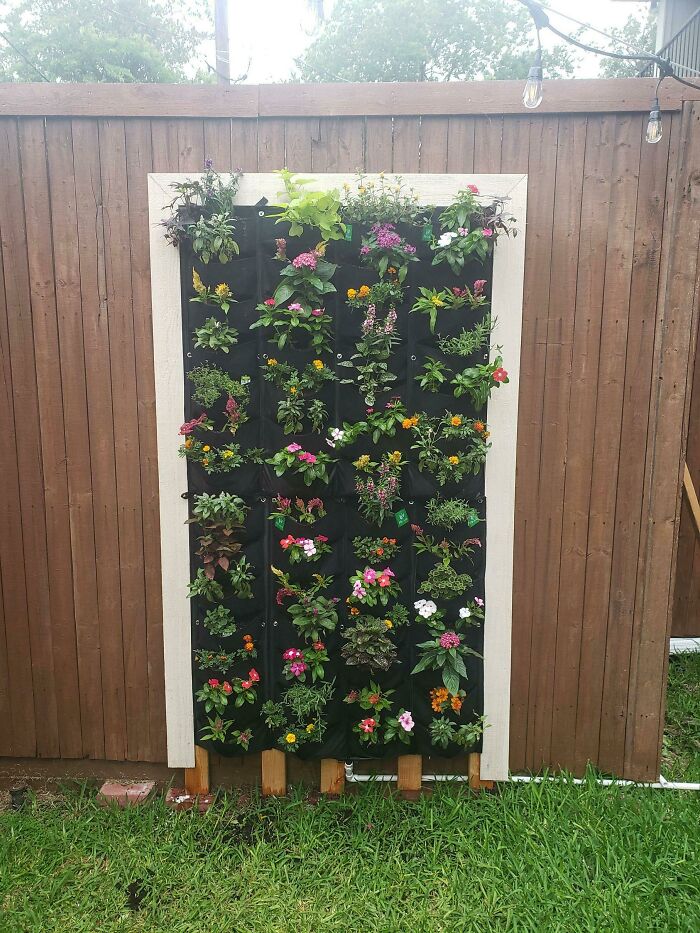
Select a suitable vertical structure – a hanging pocket organizer, a wall-mounted trellis, or even recycled gutters can all work wonders. Fill your chosen containers with lightweight potting mix and plant your flowers according to the package instructions. Water regularly and enjoy the cascading blooms.
Carving Designs for a Stand-Out Fall
Ditch the traditional jack-o’-lantern and grow your unique pumpkin masterpiece by carving designs while still green. Here’s the trick: wait until your pumpkin reaches softball size and has smooth, light-green skin. Sketch your design lightly with a pencil.
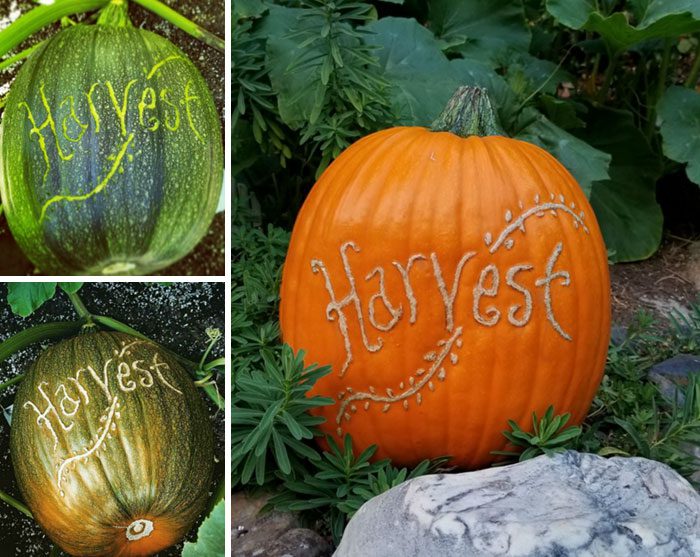
Then, carefully carve only the top layer of the rind using a dull pencil or a blunt craft tool. Don’t go deep – you don’t want to damage the flesh. As the pumpkin grows, the uncarved areas will turn orange, while the carved sections will remain a lighter shade, creating a one-of-a-kind design!
Reclaiming Your Unused Pool as a Garden
With a bit of creativity, you can transform your unused pool into a flourishing garden! First, assess the pool’s condition. If it is structurally sound, you can create a water feature in the center and build raised garden beds around the perimeter.
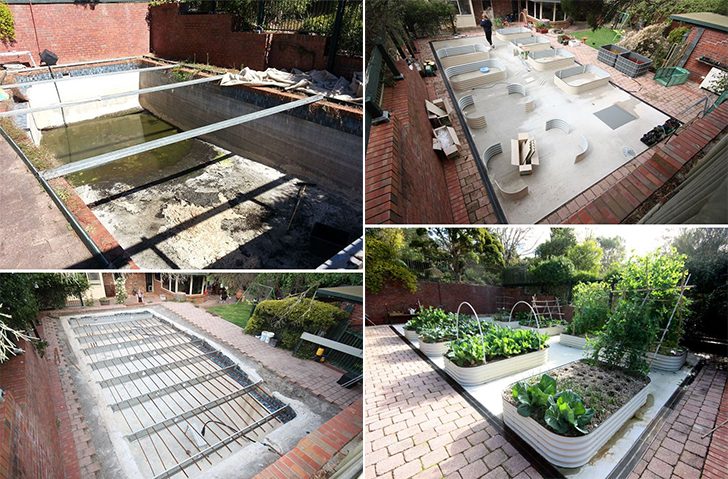
For a complete conversion, remove the pool liner and fill it with a mix of soil, creating excellent drainage. Line the sides with landscaping fabric to prevent weeds and design planting zones—shallow areas for herbs and flowers and deeper sections for shrubs and small trees.
Building a Miniature Mythical World
Craft a mythical world in miniature with this tabletop fairy garden, complete with a babbling brook! First, gather a shallow container to fit your table. Line it with plastic and fill it with pebbles for drainage. Next, create a winding streambed using smooth stones and gravel.
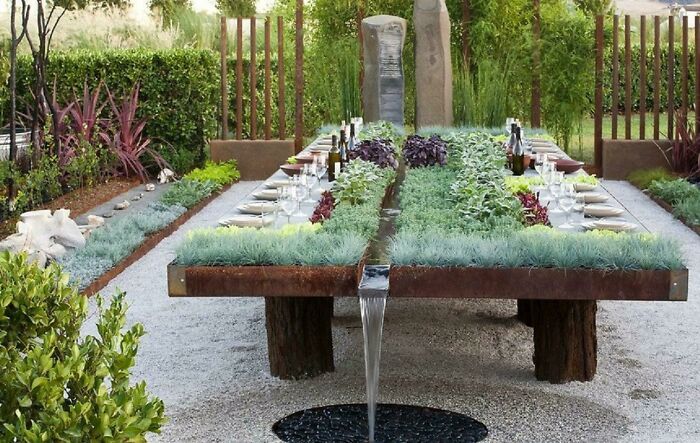
Use a small battery or solar-powered pump to circulate water from a hidden reservoir. Plant air ferns and tiny succulents for a touch of greenery. Fill the reservoir and watch your mini stream come alive, bringing a touch of magic to your tabletop.
Growing the Juiciest Pineapples
Grow the juiciest pineapples right at home! Start by saving the leafy crown from a ripe pineapple. Twist it gently to remove it, leaving a couple of inches of stem. Let the cut end dry for a few days before planting.
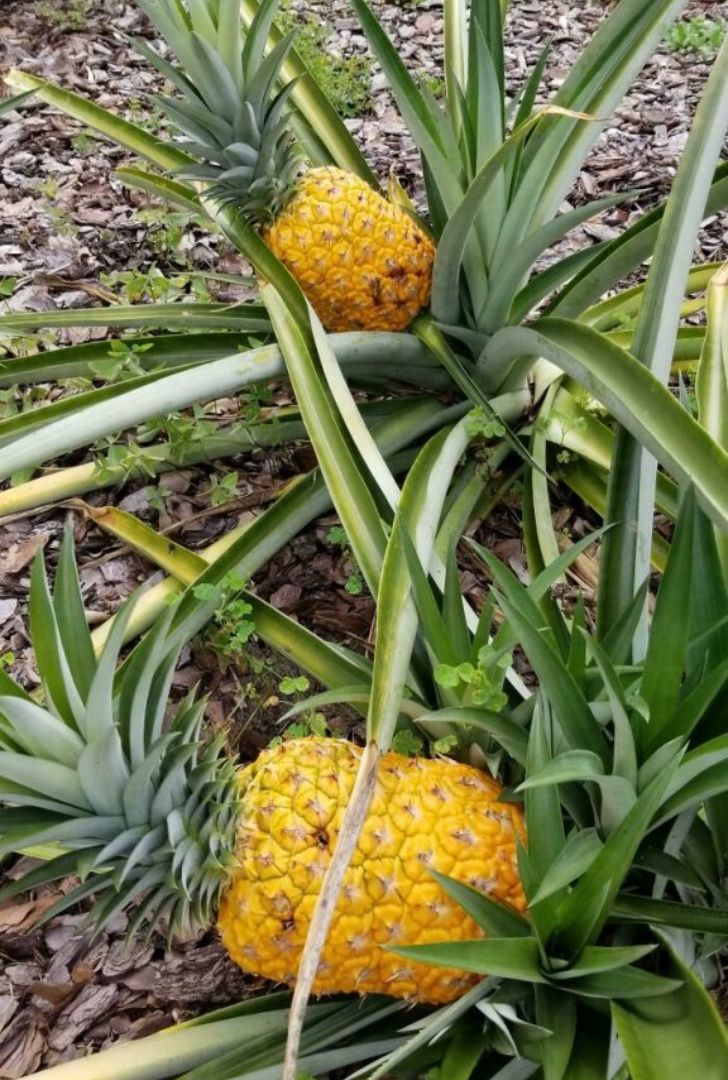
Keep it moist but not soggy, and place it in a warm, sunny spot. Pineapples love humidity, so misting the leaves regularly can help. Be patient; fruit development can take 1 to 2 years. You’ll know your pineapple is ripe when the outer skin turns golden yellow and gives a little under gentle pressure.
Create Your Own Garden Art Installation
This garden scene isn’t such a complex project. Here’s how to create your own illuminated art piece. First, find a watering can and string lights. Battery-powered fairy lights work well. If necessary, use a screwdriver to widen the holes in the watering can’s showerhead to allow the lights to pass through.
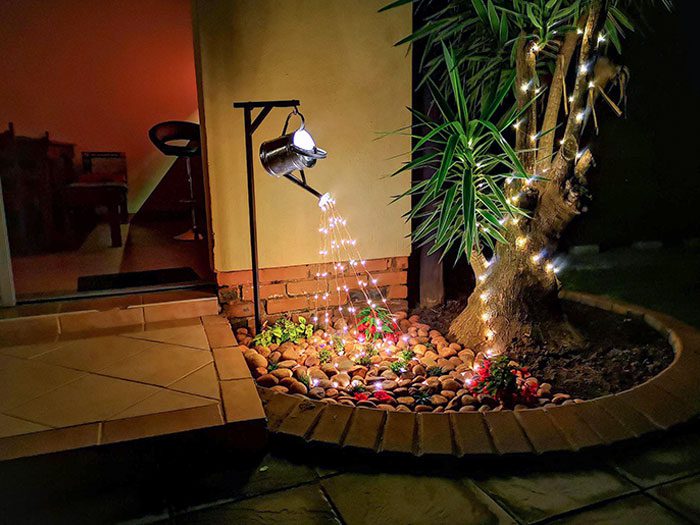
Carefully push some lights inside the can and thread the remaining string out through the spout. Play with the arrangement to create a flowing effect, like glowing water cascading out. Hang your masterpiece, place it on a shelf, and switch it on at night.
Grow Thriving Succulents on an Enclosed Porch
Transform an enclosed porch or yard into a desert oasis bursting with succulents! These low-maintenance beauties thrive in bright, indirect sunlight. Choose pots with drainage holes and fill them with a gritty, well-draining cactus mix. Arrange your succulents attractively, giving them ample space to grow.
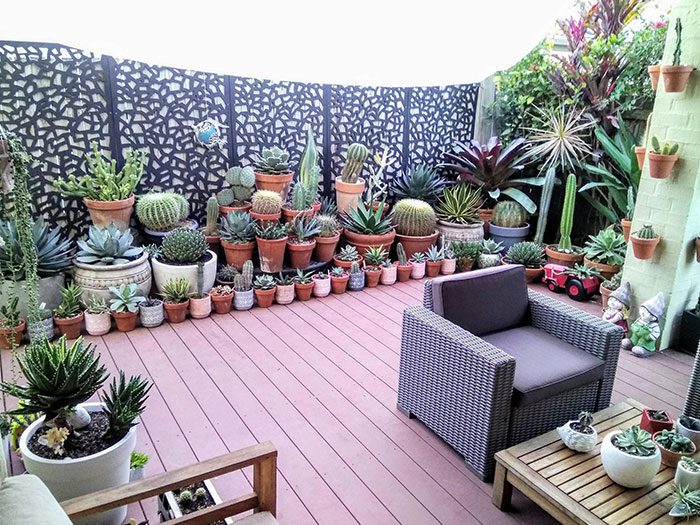
Be sure to water deeply but infrequently, allowing the soil to dry completely between waterings. Avoid overwatering, which can lead to rot. Proper drainage and light control can make your enclosed space a haven for these drought-tolerant delights.
Green up Your Space With Climbing Plants
Here’s a low-maintenance way to add life and beauty to your house. First, choose the right climbers—fast-growing varieties like pothos or ivy are perfect for beginners. Then, select a trellis or create a support system using wires or hooks on the wall.
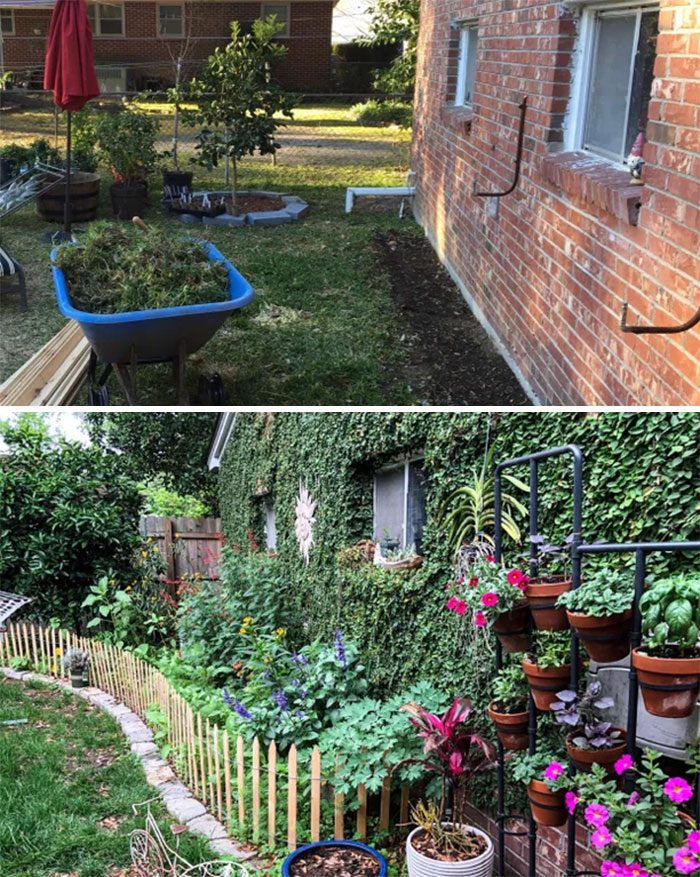
Plant your chosen climbers in pots with drainage and position them near the base of the structure. Gently train the plant’s tendrils to climb the support, weaving them upwards as they grow. With proper watering and indirect sunlight, your chosen climbers will soon transform your wall into a lush, vertical oasis.
Create a Little Seed Library
Starting a seed library is a simple way to share the bounty and encourage others to grow their own food. Gather free seeds from your garden or buy small packets in bulk. Find a weatherproof container with sections for different seeds. Label each section clearly with the seed name, planting instructions, and harvest time.
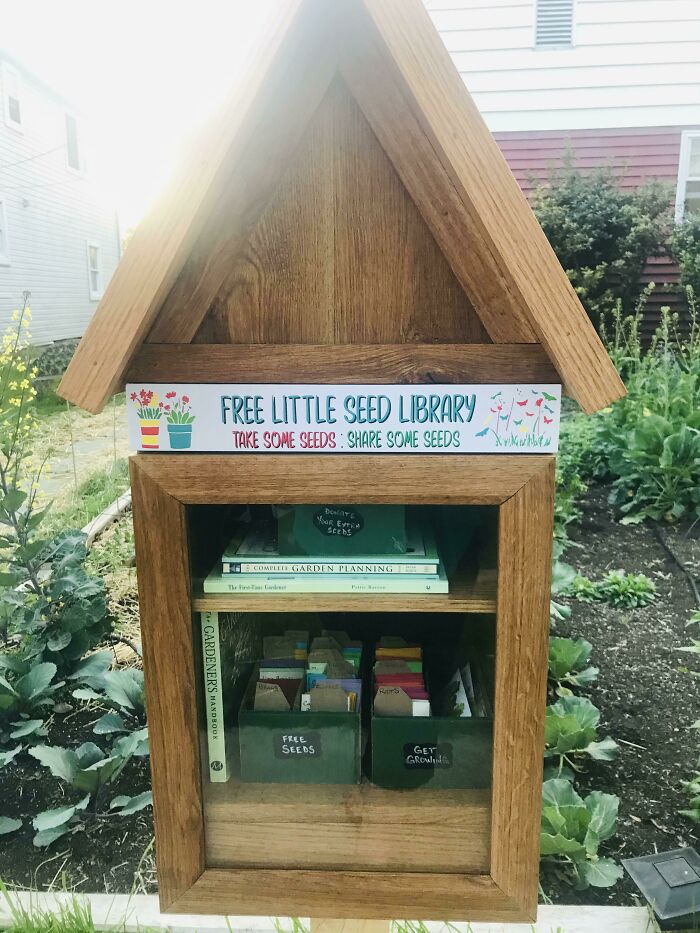
Place the seed library in a common area, like a community bulletin board or a park bench. Include a note explaining the concept: borrow seeds, plant them, and return some of your harvests next season to keep the library thriving!
Bringing Greenery to Your Concrete Space
Concrete jungles don’t have to be plant-free! Think vertical! Utilize walls with hanging planters or trellises for climbing vines. Also, choose pots in various sizes to accommodate herbs, flowers, or even small vegetables. Since concrete prevents drainage, use a good quality potting mix specifically designed for container gardens. It will provide essential nutrients and drainage for healthy plants.
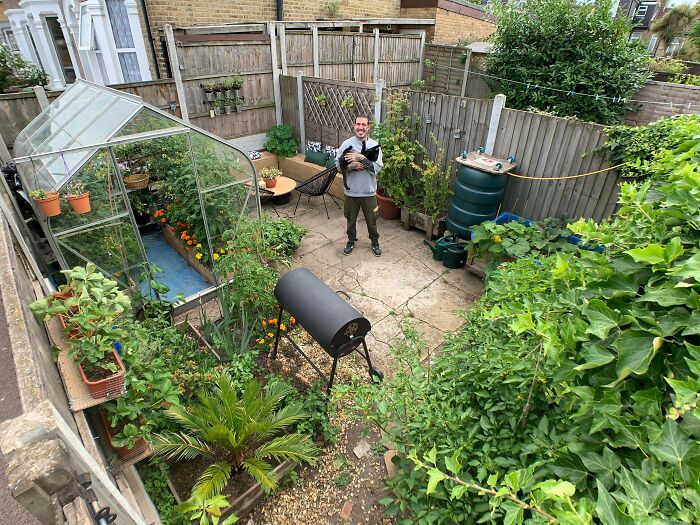
Most plants crave sunlight, so position your containers in the brightest spots possible. Regularly check your container gardens, especially during hot weather. Consistent moisture is crucial, but avoid overwatering.
Upgrade Your Garden Floor With Grass
It’s always a good idea to transform a bare garden floor into a lush green haven by sowing grass! It helps create an inviting space for picnics, playtime, or simply relaxing. Choose a grass type suited to your climate—cool-season grasses for mild winters and warm-season grasses for hot summers.
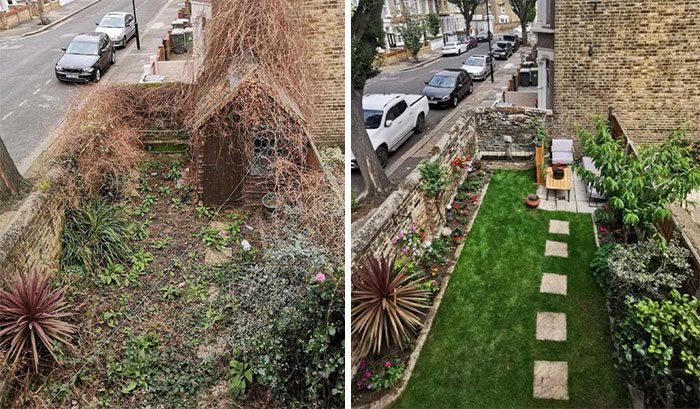
Prepare the soil by removing weeds and debris, then level and loosen the top few inches. Scatter seeds evenly and lightly rake them in for good soil contact. Keep the area moist until the grass germinates, then gradually reduce watering as it establishes.
Harness the Rain With This DIY Irrigation System
Here’s a simple, eco-friendly solution to help harness the power of the skies to water your garden. Start by installing a compatible diverter kit to the downspout on your roof. This will channel rainwater into the garden bed below. Don’t connect it directly. Instead, have a perforated pipe laid out in the garden beds.
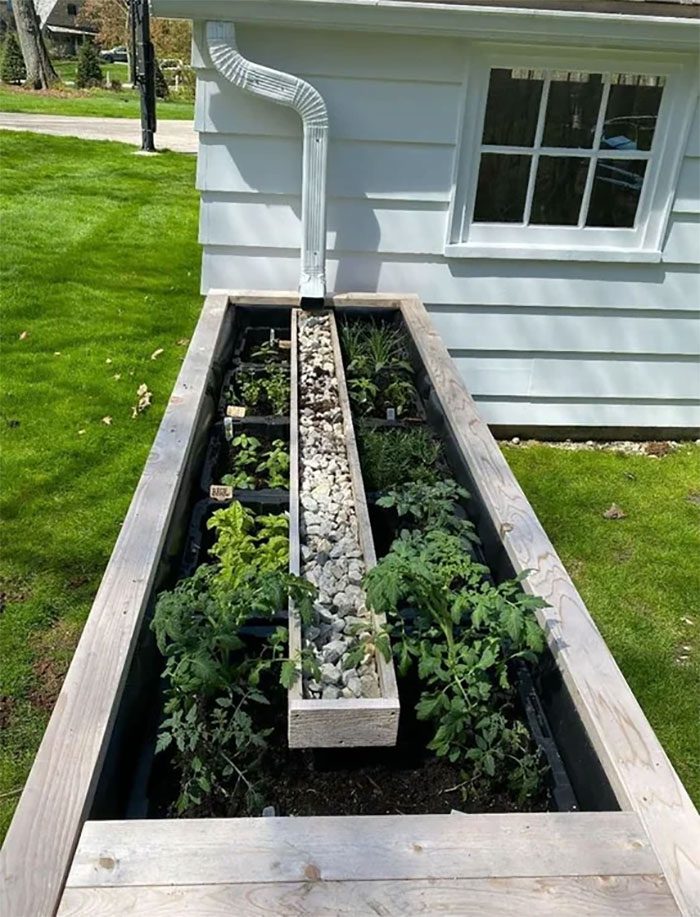
Gravity does the rest! The elevated water will naturally flow through the pipe, seeping gently into the soil to nourish your plants. This clever system saves money on water bills while giving your garden a healthy drink.
Give Your Front Lawn an Upgrade
Transform your front lawn into a vibrant display of color and flavor with a fruit and flower garden! This isn’t just about aesthetics; it can boost curb appeal, attract pollinators, and reward you with homegrown treats.
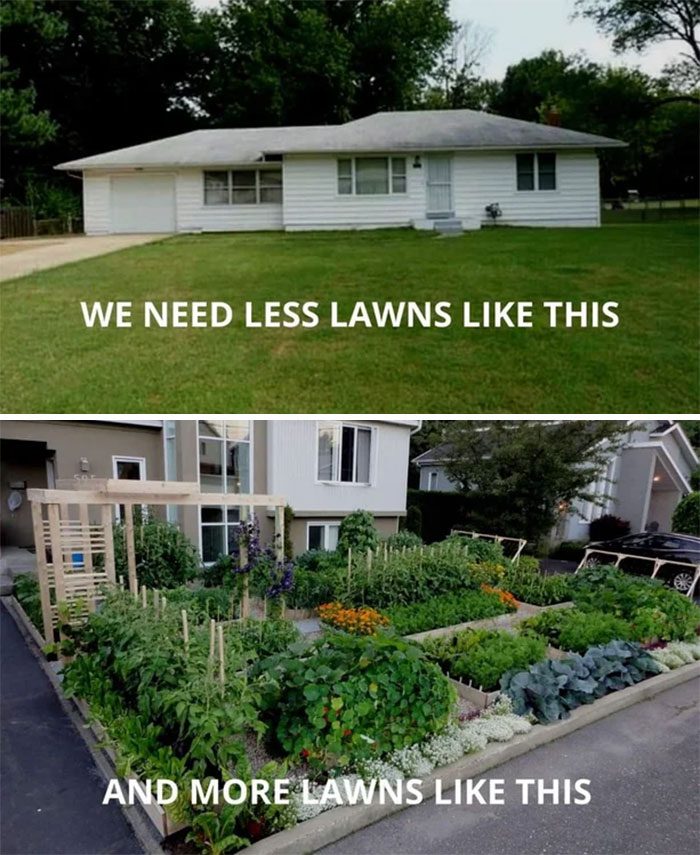
Plan strategically. Choose dwarf fruit trees or bushes that won’t obstruct walkways. Nestle flowering perennials like lavender or bee balm around them to create a visually pleasing and pollinator-friendly haven. Remember to check your local climate and choose plants that thrive in your zone.
Building a Mini Garden From Reclaimed Bricks
Don’t let those old bricks gather dust! Here’s how to transform forgotten rubble into a vibrant green haven. First, choose a sunny spot in your yard. Creatively arrange the bricks, creating a small enclosure or raised bed. Leave gaps between the bricks for planting and drainage. Fill the spaces with a quality potting mix.
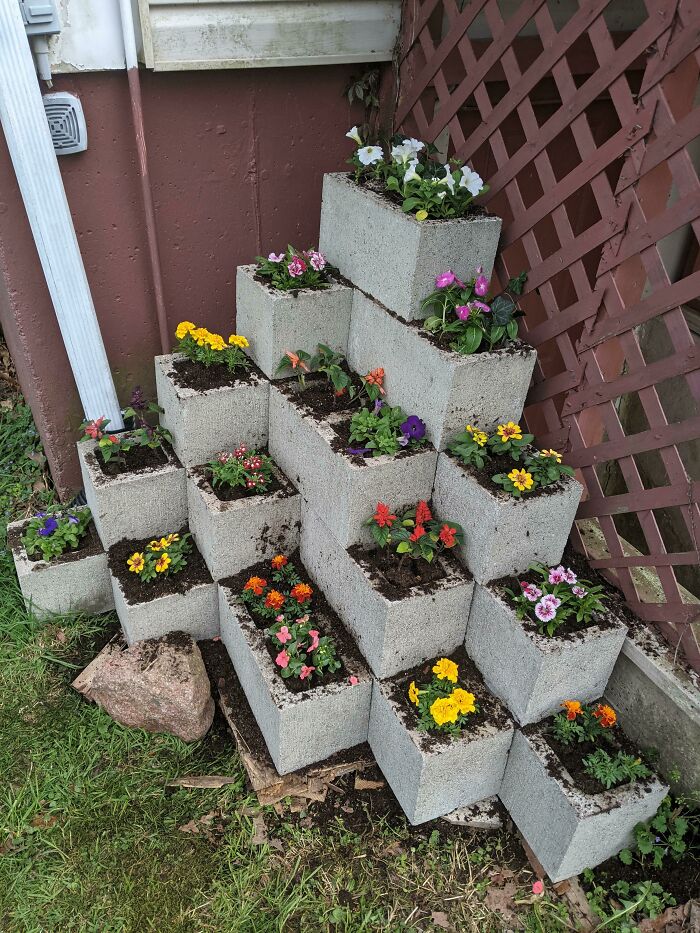
Now, select small, low-growing plants like succulents, herbs, or creeping thyme. Their shallow root systems thrive in tight spaces, and their vibrant colors will add a burst of life to your reclaimed brick haven. Soon, your recycled garden will be a charming testament to upcycling.
Crafting a Stained Glass Greenhouse
Imagine sunlight streaming through colorful panes, casting dappled patterns on your flourishing greenery. While it requires more planning than a traditional build, the result of this stained glass greenhouse will be a showstopper!
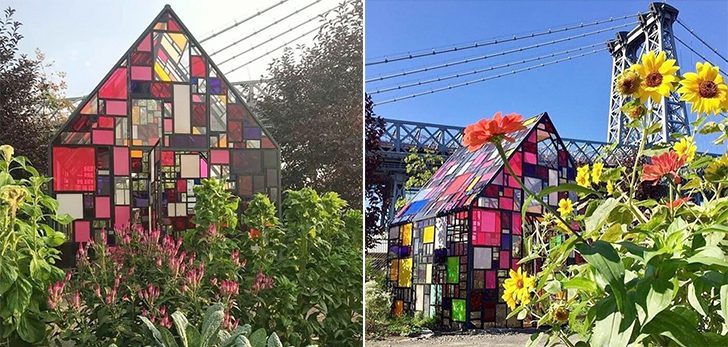
Start by creating a sturdy wooden frame for your greenhouse. Replace standard glass panels with pre-cut stained glass pieces. You can use recycled finds or purchase new glass designed explicitly for greenhouses. Secure the stained glass using the appropriate glazing techniques. Then, add ventilation to create a nurturing environment for your plants.
Succulent Seating for Your Patio
This DIY succulent bench is perfect for patios or balconies. First, gather cinder blocks or sturdy bricks for the base. Stack them at a comfortable bench height and create a rectangular shape. For the seat, use pre-cut wooden planks or a reclaimed pallet. Secure the wood to the cinder block base using brackets or screws.
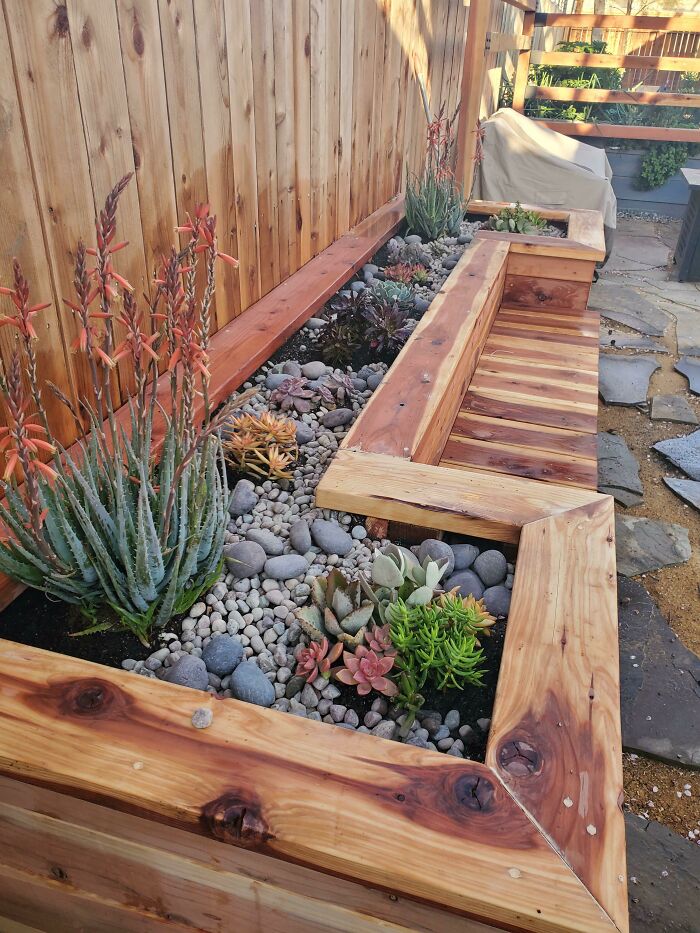
Line the wooden seat with landscaping fabric to prevent weeds and add a layer of coarse gravel for drainage. Top it all off with a high-quality succulent potting mix. Finally, arrange a variety of colorful and textured succulents across the surface.
Thriving Garden Ideas for Hot and Dry Climates
Who says you can’t cultivate a flourishing garden even in scorching temperatures? The key lies in choosing the right plants and utilizing smart techniques. Embrace drought-tolerant beauties like cacti, succulents, and ornamental grasses. They thrive on minimal water and require well-draining soil.
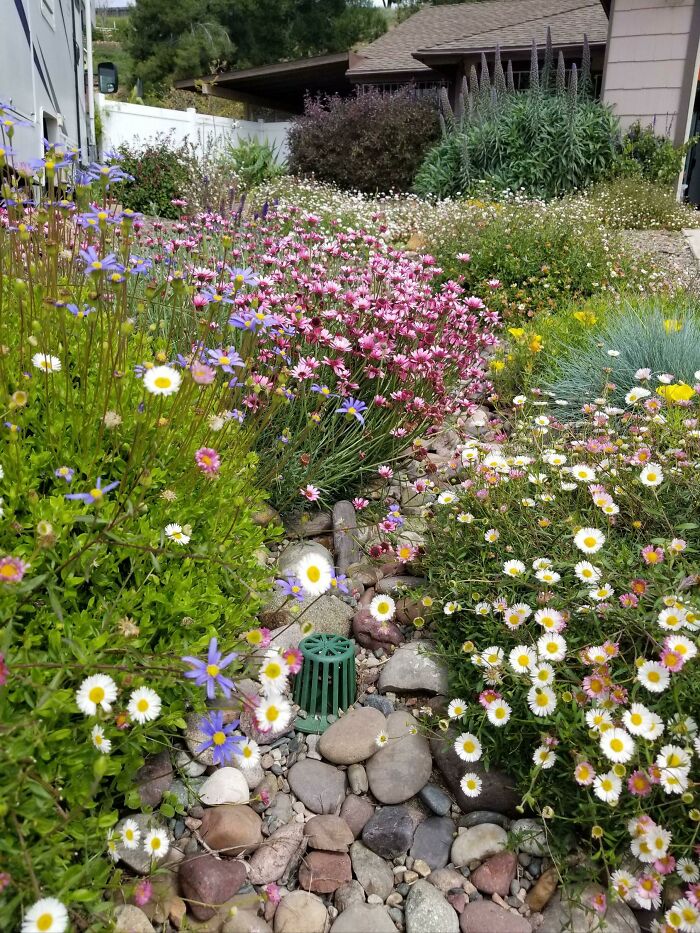
Group plants strategically to create shade for each other, reducing water evaporation. Utilize mulch around your plants to retain moisture and suppress weeds. Also, embrace mornings for watering and allow the soil to dry before the harsh afternoon sun.
A Bee Buffet Bonanza to Support Pollinators
Forgo the fancy flowers and plant a bee buffet with towering sunflowers! These cheerful giants aren’t just beautiful; they’re a vital food source for pollinators like bees. Sunflowers produce abundant pollen rich in nutrients and oils essential for bee growth and health.
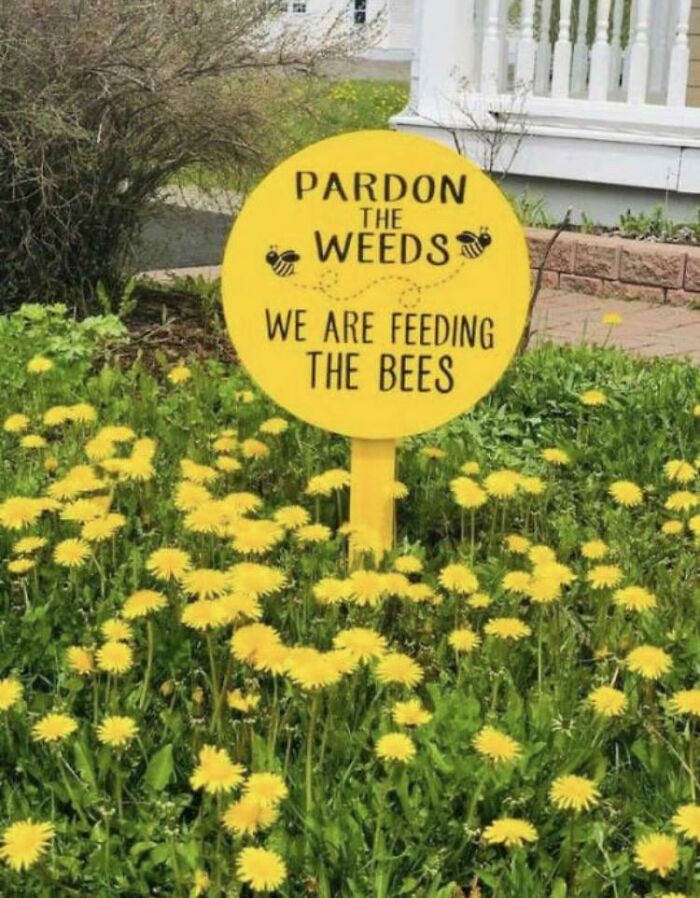
By nurturing a sunflower patch, you’re helping these crucial creatures. Remember, healthy bees mean a healthy ecosystem, as they pollinate a third of the food we eat! So plant tall, watch them grow, and let the bees enjoy a delicious feast.
Grow Your Own Shady Retreat
Here’s how to cultivate a haven of greenery you can sit inside. Plant fast-growing climbers like morning glories or clematis around a circular frame. Train them to climb the structure as they mature, creating a lush, living dome. Opt for varieties with fragrant blooms or cascading foliage for an extra sensory experience.
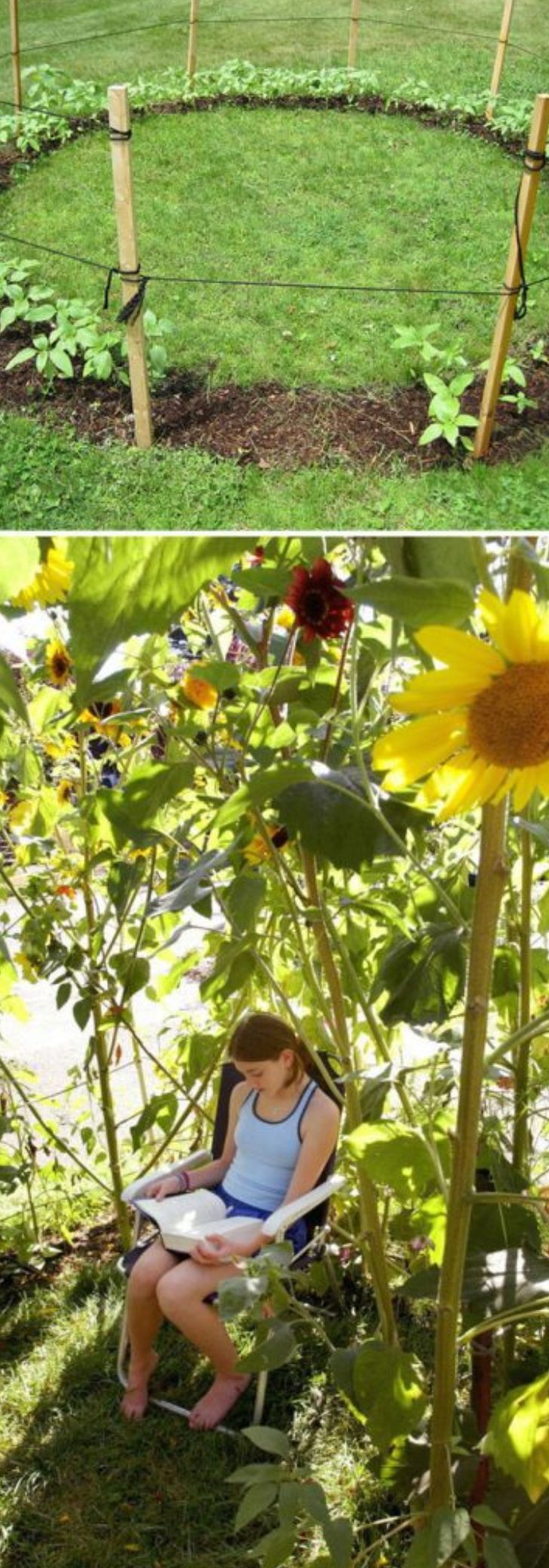
This isn’t just about aesthetics. During hot days, the dense foliage will provide welcome shade, allowing you to relax outdoors comfortably. It’s a sustainable and beautiful way to beat the heat, all while nurturing nature.
Embrace Flowing Function With This Stone-Lined Stream
This manmade stone-lined stream will transform your yard into a functional work of art. It’s a simple yet impactful solution that protects your property from water damage while adding a touch of natural beauty.
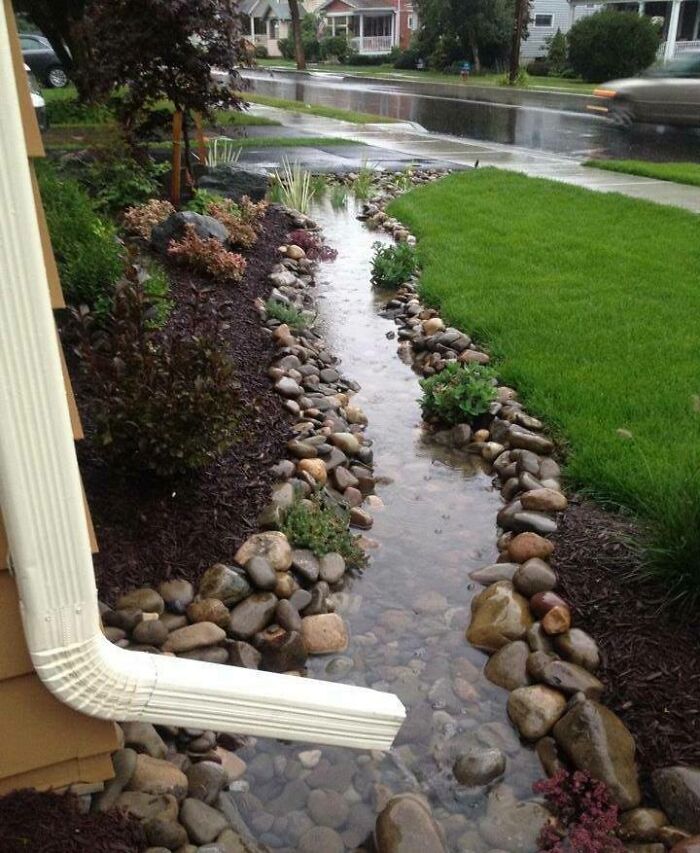
Excess water during heavy downpours can cause flooding and erosion. By creating a channeled stream bed lined with stones, you can provide a designated path for water to flow, directing it away from problem areas and into a suitable drainage point. So, grab some stones, get creative, and let your garden flow!
Urban Oasis on a Rooftop
This isn’t just about aesthetics. Rooftop gardens help insulate buildings, reducing energy costs. They also absorb rainwater, lessening the strain on drainage systems. Plus, they create a beautiful shared space for residents to relax, socialize, or simply enjoy a breath of fresh air amidst the urban jungle.
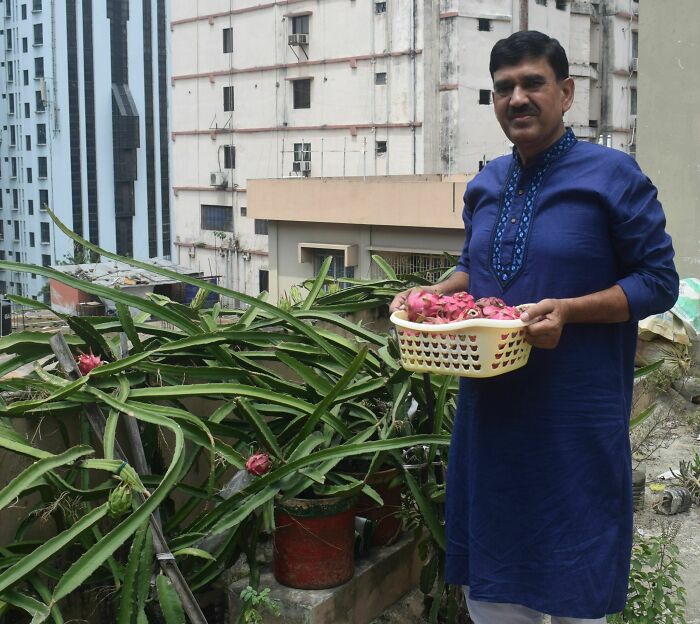
First, check with your building management to ensure rooftop access and weight restrictions. Next, choose lightweight containers and drought-tolerant plants for a low-maintenance paradise. With a bit of planning and collaboration, your rooftop can be transformed into a vibrant space like this one.
From Nothing to Something
Does your wide, enclosed backyard feel a bit too vast and empty? Here’s how to create a sense of intimacy and visual interest with greenery. Break up the space with strategically placed trees and shrubs. Opt for varieties with different heights and textures to create a layered effect. These will also provide pockets of shade and privacy around the yard.
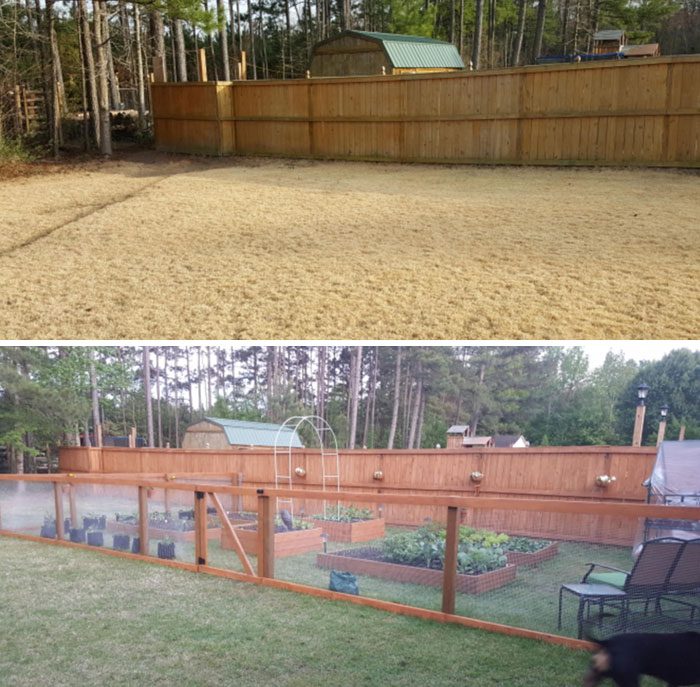
Don’t forget container gardening! Place colorful planters filled with herbs, flowers, or small ornamental trees throughout the space. Finally, create designated seating areas or pathways. Now, your once-empty yard can be a pleasant space.
A Blooming Waterfall of Flowers
This unique flowerbed will be a focal point in your garden, sure to impress guests and neighbors. Here’s how to turn your vision into reality. Construct a wooden flowerbed with holes in the side. Ensure it has drainage holes to prevent waterlogging.
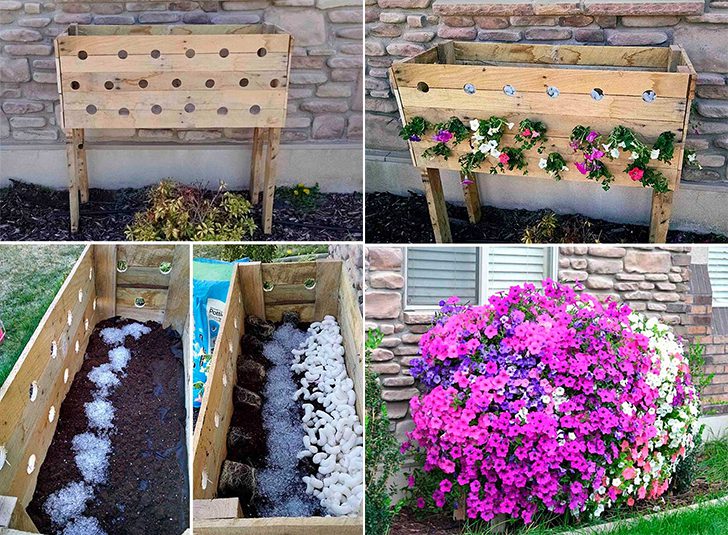
Line the bed with weed fabric and fill it with a high-quality potting mix. Next, choose cascading flowers like petunias, verbena, or lobelia. Plant them densely close to the cutouts so they can spill out. They’ll tumble down the frame as they grow, creating a vibrant, overflowing waterfall of color.
How to Create Ambiance on a Small Patio
Even a small patio can become a cozy haven for relaxation. Here’s how to maximize your space and create an inviting atmosphere. Multifunctional furniture is key. So, opt for ottomans with backrests so the storage compartments can be a place to stash gardening tools.
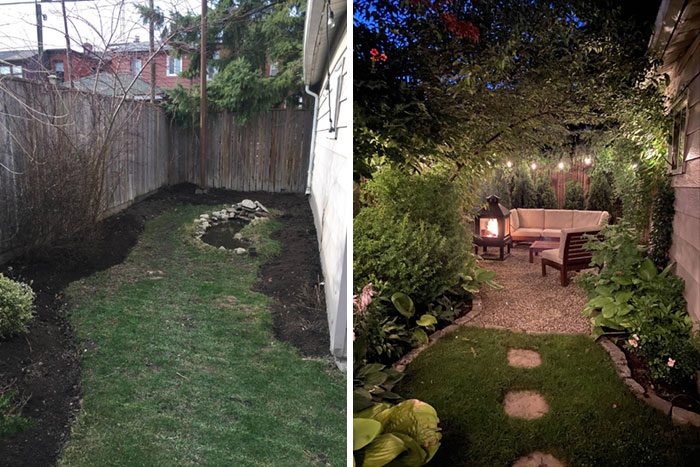
Plants soften the space and add pops of color. Place tall planters filled with ferns or small trees in corners to create a sense of enclosure. Hang trailing vines from the railings or display colorful flowers in window boxes. String lights hung overhead can create a magical ambiance in the evenings.
Helping Heavy Watermelons Thrive
While the idea of using a bra to grow watermelons is an interesting conversation starter, it’s not the most practical method. Watermelons are heavy and require strong support to thrive. Here’s a more helpful suggestion:
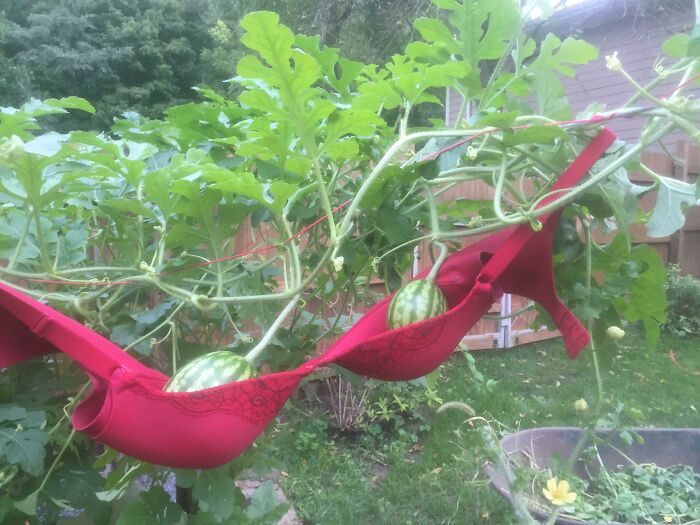
Find a sling made from sturdy netting or fabric and secure it horizontally between two poles or a trellis. As your watermelon grows, gently place it in the sling for support. The sling will distribute the weight evenly, preventing the fruit from splitting or straining the vine.
Every Small Effort Counts
Don’t let heavy, premature fruit weigh down your young tree! Here’s a quick fix using scrap wood to create a supportive tent. First, gather sturdy branches and cut them to similar lengths. Carefully arrange them in a triangular shape around the fruit, forming a makeshift tripod. Secure the top ends of the branches with twine or rope to create a stable structure.
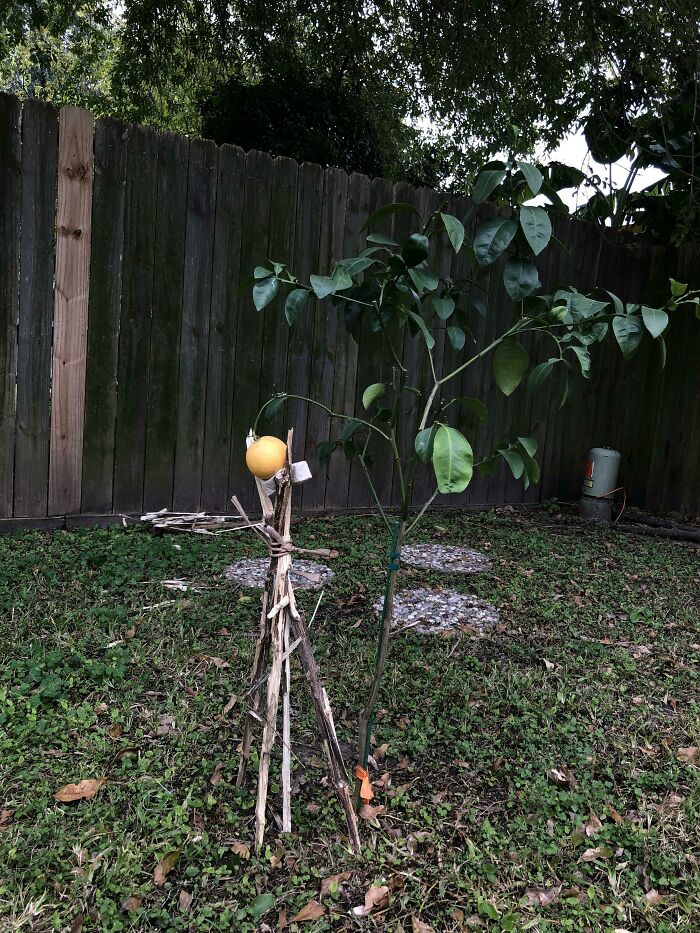
Place the fruit you hope to secure onto the wooden frame, ensuring it rests comfortably within the support structure. This DIY tent will distribute the weight evenly and allow the fruit to mature healthily.
From Wild to Wonderful
Here’s how to turn overgrown weeds into a landscaped seating area. First things first: grab your gloves and tackle the weeds! A weed whacker or sturdy rake will work fine. Once the yard is cleared, define the seating area by outlining it with stones, bricks, or edging. This will separate your garden from the surrounding space.

Consider repurposing old furniture or building simple wooden benches for seating. Add a touch of nature with grass, vibrant flowers, and fragrant herbs. With a little effort, your weed-filled yard can become a perfect retreat for enjoying the outdoors.
Building a Koi Garden With a Walkway
This koi garden looks like a dream, so here’s how to bring it to life. First, choose a location with ample sunlight. Dig a pond, ensuring proper depth and lining it with a pond liner specifically designed for koi. Next, create a recirculating pump and filtration system to maintain healthy water quality for your fish.
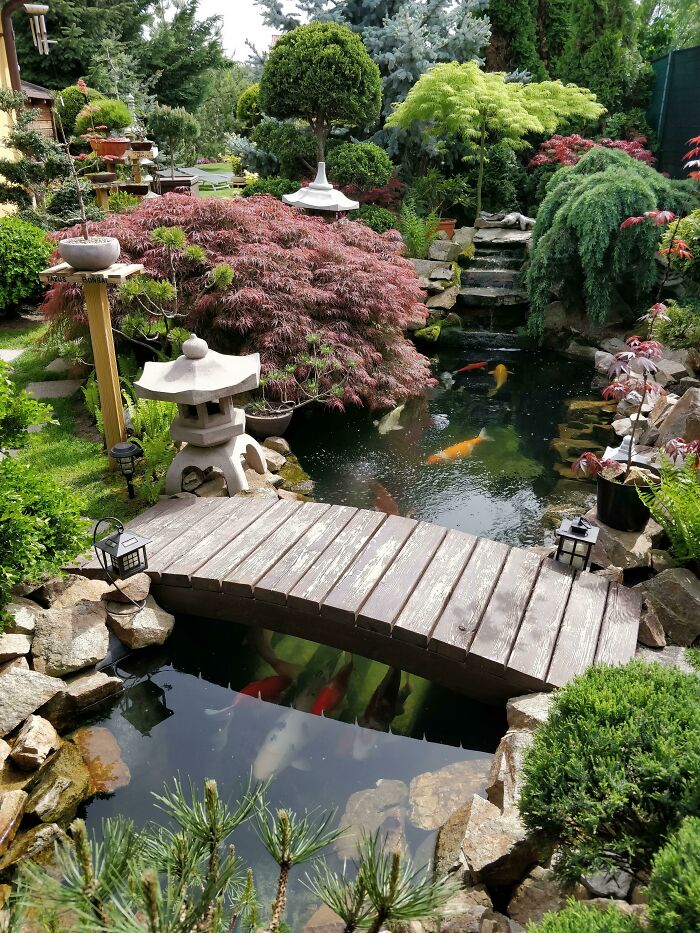
Now for the beauty! Decorate the pond with aquatic plants that provide oxygen and hiding spots for the koi. Arrange rocks and gravel around the perimeter for a natural look. Finally, build a small bridge from weather-treated wood or stone slabs.
Planting a Wildflower Strip
This wildflower strip is used in Europe to provide vital food and habitat for essential pollinators. So, here’s how to help the bees and add beauty to your landscape. Choose a sunny spot along the border or middle of your field. Research native wildflowers that bloom throughout the season to ensure a continuous food source for the bees.
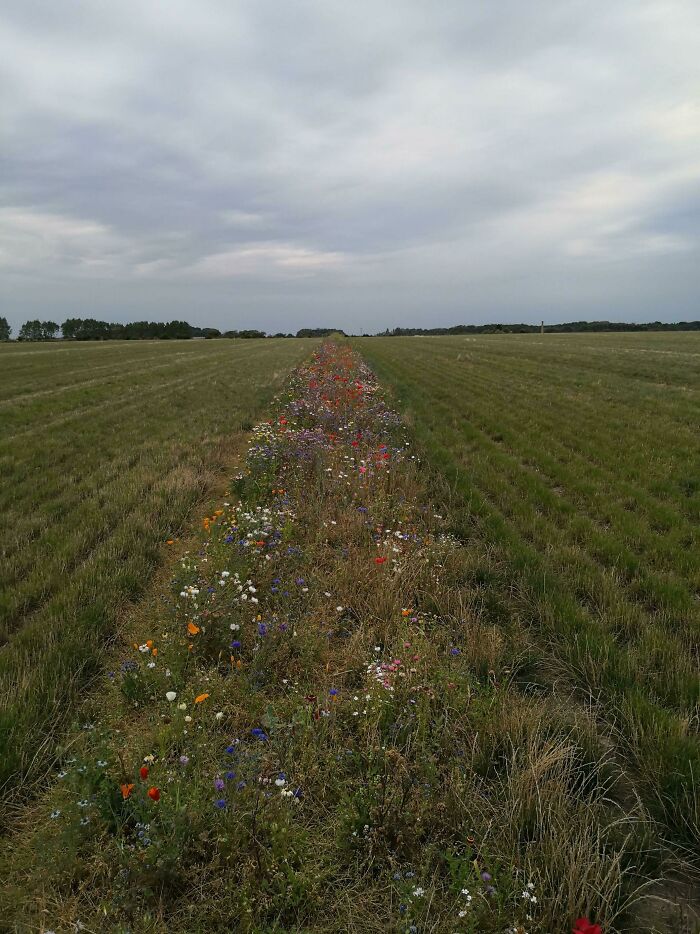
Prepare the soil by removing weeds and debris. Scatter the wildflower seeds directly onto the soil and lightly rake them in for good contact. Water regularly until the seeds germinate, then let nature take its course.
Yes, Plants Can Grow in Pipes
To transform your building’s facade into a vertical garden with a PVC pipe planting system, find sturdy PVC pipes and cut them into manageable lengths. Attach them vertically to the wall using appropriate brackets, ensuring proper drainage holes at the base. Line the pipes with weed fabric and fill them with a lightweight, well-draining potting mix.
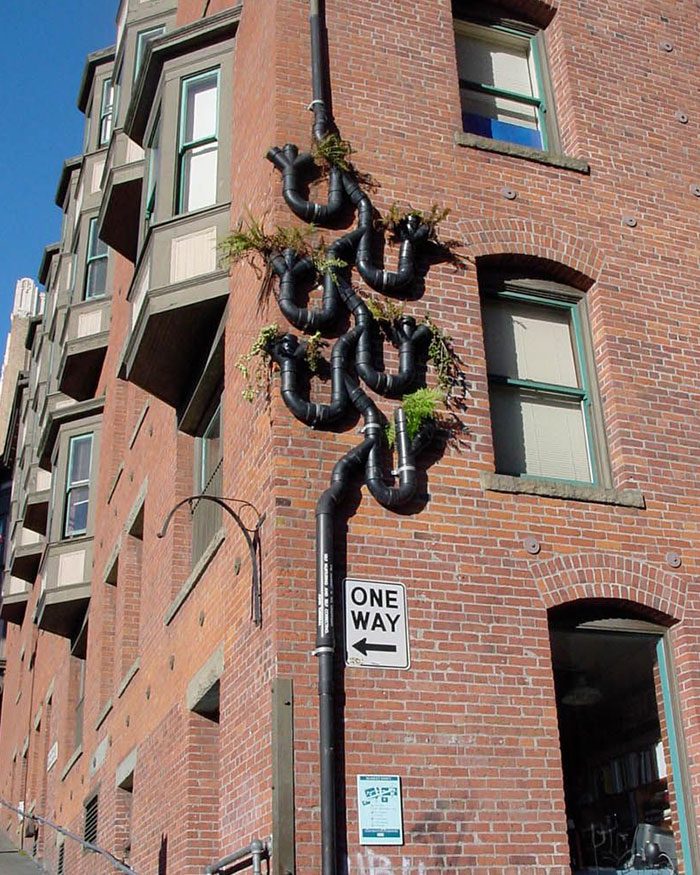
Next, choose plants like cascading succulents, flowering vines, or trailing herbs. Plant them at the top of the pipes and let them tumble down the sides. As they grow, they’ll create a living curtain that softens the building’s exterior as they grow.
A Geometric Bounty of Honeycomb Plant Beds
These unique beds will add a touch of geometric charm to any garden while providing a thriving space for plants. Here’s how to build your own bee-inspired bounty. Gather wooden boards and cut them into equal lengths. Using a saw, create 60-degree angles on each end to form hexagons. Secure the angled boards together using wood glue and clamps to create individual hexagons.
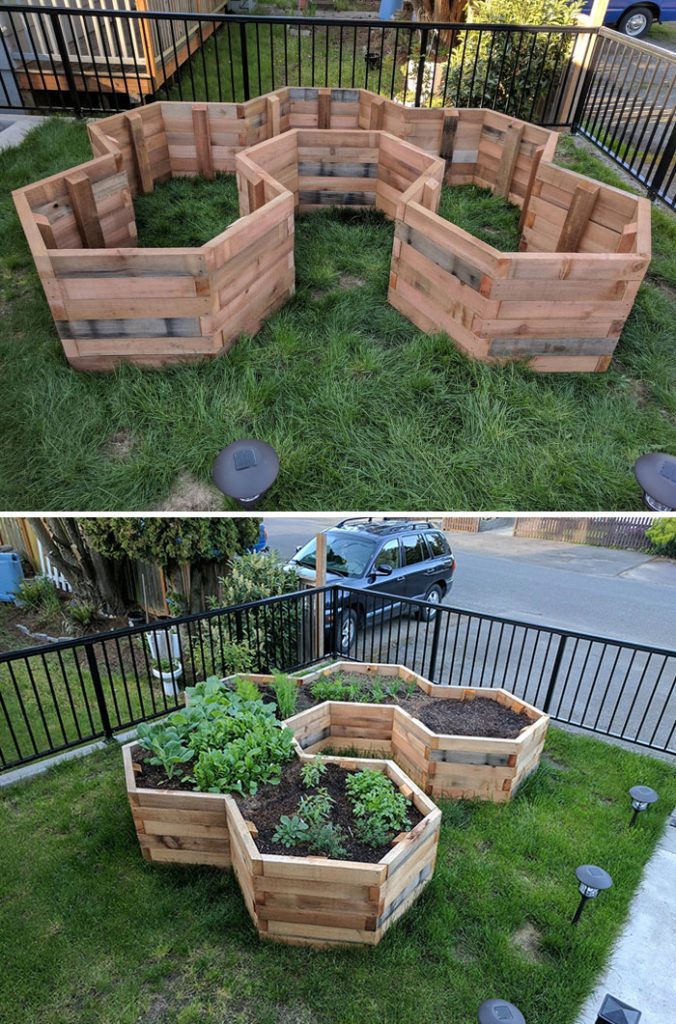
Once you have several hexagons, assemble them into honeycomb clusters! Line the finished beds with landscaping fabric and fill them with high-quality potting mix. Finally, plant your favorite herbs, flowers, or vegetables, one hexagon at a time!
Caged and Content
Iron plant cages aren’t just decorative; they offer a surprising range of benefits. Here’s why you might consider incorporating them into your indoor gardening. First, iron cages provide excellent protection for plants that are vulnerable to curious pets or rambunctious children. The sturdy bars act as a barrier, preventing playful paws or grabbing hands from disturbing sensitive leaves or stems.
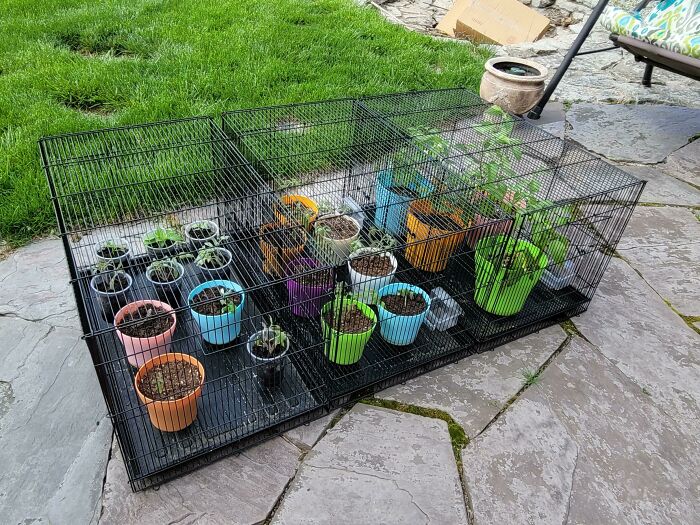
Iron cages can also offer much-needed support for climbing plants. As your vines grow, they can weave themselves around the cage, creating a beautiful and structured display.
They also add a touch of vintage charm to your décor.
You must be logged in to post a comment Login